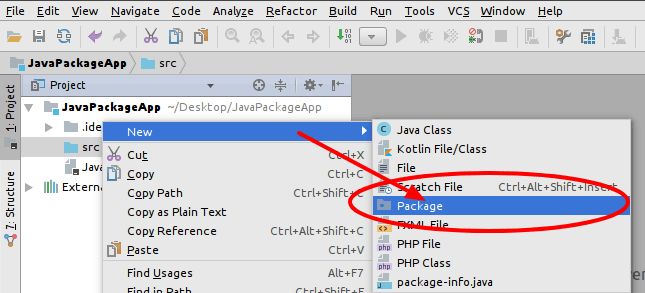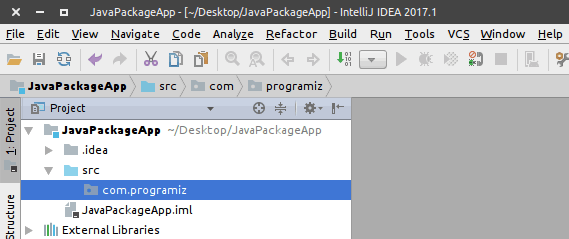- Java Package
- Built-in Package
- User-defined Package
- How to define a Java package?
- Package Naming convention
- How to create a package in Intellij IDEA?
- How to import packages in Java?
- Example: Package and importing package
- Table of Contents
- Java Packages
- Built-in Packages
- Syntax
- Import a Class
- Example
- Example
- Import a Package
- Example
- User-defined Packages
- Example
- MyPackageClass.java
Java Package
A package is simply a container that groups related types (Java classes, interfaces, enumerations, and annotations). For example, in core Java, the ResultSet interface belongs to the java.sql package. The package contains all the related types that are needed for the SQL query and database connection.
If you want to use the ResultSet interface in your code, just import the java.sql package (Importing packages will be discussed later in the article).
As mentioned earlier, packages are just containers for Java classes, interfaces and so on. These packages help you to reserve the class namespace and create a maintainable code.
For example, you can find two Date classes in Java. However, the rule of thumb in Java programming is that only one unique class name is allowed in a Java project.
How did they manage to include two classes with the same name Date in JDK?
This was possible because these two Date classes belong to two different packages:
- java.util.Date — this is a normal Date class that can be used anywhere.
- java.sql.Date — this is a SQL Date used for the SQL query and such.
Based on whether the package is defined by the user or not, packages are divided into two categories:
Built-in Package
Built-in packages are existing java packages that come along with the JDK. For example, java.lang , java.util , java.io , etc. For example:
import java.util.ArrayList; class ArrayListUtilization < public static void main(String[] args) < ArrayListmyList = new ArrayList<>(3); myList.add(3); myList.add(2); myList.add(1); System.out.println(myList); > > The ArrayList class belongs to java.util package . To use it, we have to import the package first using the import statement.
User-defined Package
Java also allows you to create packages as per your need. These packages are called user-defined packages.
How to define a Java package?
To define a package in Java, you use the keyword package .
Java uses file system directories to store packages. Let’s create a Java file inside another directory.
Now, edit Test.java file, and at the beginning of the file, write the package statement as:
Here, any class that is declared within the test directory belongs to the com.test package.
package com.test; class Test < public static void main(String[] args)< System.out.println("Hello World!"); >> Here, the Test class now belongs to the com.test package.
Package Naming convention
The package name must be unique (like a domain name). Hence, there’s a convention to create a package as a domain name, but in reverse order. For example, com.company.name
Here, each level of the package is a directory in your file system. Like this:
And, there is no limitation on how many subdirectories (package hierarchy) you can create.
How to create a package in Intellij IDEA?
In IntelliJ IDEA, here’s how you can create a package:
- Right-click on the source folder.
- Go to new and then package.
- A pop-up box will appear where you can enter the package name.
Once the package is created, a similar folder structure will be created on your file system as well. Now, you can create classes, interfaces, and so on inside the package.
How to import packages in Java?
Java has an import statement that allows you to import an entire package (as in earlier examples), or use only certain classes and interfaces defined in the package.
The general form of import statement is:
import package.name.ClassName; // To import a certain class only import package.name.* // To import the whole package
import java.util.Date; // imports only Date class import java.io.*; // imports everything inside java.io package
The import statement is optional in Java.
If you want to use class/interface from a certain package, you can also use its fully qualified name, which includes its full package hierarchy.
Here is an example to import a package using the import statement.
import java.util.Date; class MyClass implements Date < // body >
The same task can be done using the fully qualified name as follows:
class MyClass implements java.util.Date < //body >
Example: Package and importing package
Suppose, you have defined a package com.programiz that contains a class Helper .
package com.programiz; public class Helper < public static String getFormattedDollar (double value)< return String.format("$%.2f", value); >> Now, you can import Helper class from com.programiz package to your implementation class. Once you import it, the class can be referred directly by its name. Here’s how:
import com.programiz.Helper; class UseHelper < public static void main(String[] args) < double value = 99.5; String formattedValue = Helper.getFormattedDollar(value); System.out.println("formattedValue Importing packages in Java" height="177" src="https://cdn.programiz.com/sites/tutorial2program/files/import-package-java_0.jpg" title="Java import package" width="400">Java import package
In Java, the import statement is written directly after the package statement (if it exists) and before the class definition.
For example,
package package.name; import package.ClassName; // only import a Class class MyClass < // body >
Table of Contents
Java Packages
A package in Java is used to group related classes. Think of it as a folder in a file directory. We use packages to avoid name conflicts, and to write a better maintainable code. Packages are divided into two categories:
- Built-in Packages (packages from the Java API)
- User-defined Packages (create your own packages)
Built-in Packages
The Java API is a library of prewritten classes, that are free to use, included in the Java Development Environment.
The library contains components for managing input, database programming, and much much more. The complete list can be found at Oracles website: https://docs.oracle.com/javase/8/docs/api/.
The library is divided into packages and classes. Meaning you can either import a single class (along with its methods and attributes), or a whole package that contain all the classes that belong to the specified package.
To use a class or a package from the library, you need to use the import keyword:
Syntax
import package.name.Class; // Import a single class import package.name.*; // Import the whole package Import a Class
If you find a class you want to use, for example, the Scanner class, which is used to get user input, write the following code:
Example
In the example above, java.util is a package, while Scanner is a class of the java.util package.
To use the Scanner class, create an object of the class and use any of the available methods found in the Scanner class documentation. In our example, we will use the nextLine() method, which is used to read a complete line:
Example
Using the Scanner class to get user input:
import java.util.Scanner; class MyClass < public static void main(String[] args) < Scanner myObj = new Scanner(System.in); System.out.println("Enter username"); String userName = myObj.nextLine(); System.out.println("Username is: " + userName); >> Import a Package
There are many packages to choose from. In the previous example, we used the Scanner class from the java.util package. This package also contains date and time facilities, random-number generator and other utility classes.
To import a whole package, end the sentence with an asterisk sign ( * ). The following example will import ALL the classes in the java.util package:
Example
User-defined Packages
To create your own package, you need to understand that Java uses a file system directory to store them. Just like folders on your computer:
Example
└── root └── mypack └── MyPackageClass.java
To create a package, use the package keyword:
MyPackageClass.java
package mypack; class MyPackageClass < public static void main(String[] args) < System.out.println("This is my package!"); >> Save the file as MyPackageClass.java, and compile it:
This forces the compiler to create the "mypack" package.
The -d keyword specifies the destination for where to save the class file. You can use any directory name, like c:/user (windows), or, if you want to keep the package within the same directory, you can use the dot sign " . ", like in the example above.
Note: The package name should be written in lower case to avoid conflict with class names.
When we compiled the package in the example above, a new folder was created, called "mypack".
To run the MyPackageClass.java file, write the following:


